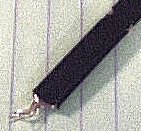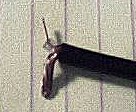|
|
|
|
Most of the instructions you'll find online gives certain specifications beyond just the length of the line. So do mine.
Okay, here's your parts list:
Optional parts:
And the tools needed:
Assembly: Accurately measure and cut 54-1/2" of twin-lead. Make the cuts square to the lead.  Carefully strip 1/2" insulation off one end (will become the bottom). Cross the two wires and solder. Measure from the bottom of the insulation (not the soldered wires) up 1-1/4" and mark. Now, strip 1/8" insulation off the wires, starting at the mark and working down. Remove only the insulation touching the wire, leave the center portion intact.  From the mark, measure 15-1/4" up and mark. Measure up another 1/4" and mark. On one side only, remove the wire between the marks. If you measured correctly, the distance from the top of the cut to the top of the lead is 37-1/4". Don't worry if it's slightly off, the antenna SWR is very broad across the band. Now, back at the bottom, apply a small bit of RTV over the soldered wires, cover with tape, then cover with heat shrink.  At the exposed wires, attach the coax. The center conductor connects to the long side (radiator), the shield connects to the short - cut - side. Expose only enough coax to make the connections without pulling the antenna wires together. Apply a small bit of RTV to the exposed wires, then wrap once with tape. Dress the coax down along the twin lead and use one more wrap of tape to hold it in place. Cover with enough heat shrink to cover the first 1-1/2" of twin lead. Don't shrink too tight or you'll curl the twin lead and change its characteristics. That's it! Next step is to hang the antenna and give it a whirl. A few things I learned and read elsewhere:
My first and best antenna had no balun or ferrite beads, but is only fed by an HT at low power. Your 50-watt transmitter might cause significant RF coupling to warrant filtering. I didn't tune mine because I don't have a VHF SWR meter and my HF SWR meter couldn't do the job. But performance is excellent (the J-pole at surface outperformed the dipole at 30'). My first modification was to encase the antenna. Since my first was to be used in a permanent location, I decided to dress it up a little more. You'll need two sections of PVC pipe, preferably 1/2" or 3/8" ID. It's not too wide and large enough inside to hold the antenna (the feedpoint will be the thickest section. I specified the white schedule 40 PVC simply because it has no RF characteristics, and it's cheaper than schedule 80. The gray pipe will influence your antenna and should be avoided. Cut one section 6' long, another 2' long. Clean the cut end on the long piece to minimize interference while threading the antenna. The two sections will be connected via the T to make an 8'3" pipe with a takeoff. The long section will contain the antenna while the short section can be used for mounting, and the coax will exit via the T. Now, apply some PVC cleaner to the bottom of the long portion and the inside of the T (the long side of the T), then apply PVC cement to those same sections. Push the T onto the long section and twist it a little bit. In short order, the cement will harden and hold the pieces together. Repeat the process to attach the short section to the bottom of the T. At the top, dry-fit the end cap, then measure up 1/4" from the bottom of the cap (the pipe end). Drill a 1/8" hole through the pipe cap, pipe, and out the other side. Accuracy isn't important here, but try to be as close as you can. Now remove the cap and trim or rasp material away so the hole becomes a slot. Next, begin feeding the twin lead into the side of the T and up the long section. It'll feed fairly easily until you reach the feedpoint. Make sure that you don't push too hard, possibly bending the antenna at the feedpoint (the weakest point). Try keeping the antenna flat against the back of the pipe, it'll make fishing the coax in easier. Alternatively, use a fishtape to pull the antenna through, but don't pull too hard or you'll damage the feedpoint again. Once you reach the top, feed a wire tie through the hole at the top of the pipe and through the hole at the top of the antenna, exiting the other side of the pipe and secure loosely. Now replace the cap so the wire tie feeds through the slots. Do not cement the cap because you will need to gain access to the antenna (if the wire tie breaks through the twin lead insulation, for example). With the cap in place, tighten the wire tie so it holds the cap on the pipe. Mount the antenna using pipe clamps (two or more) or a mounting plate. Check it for good SWR again, then enjoy. |